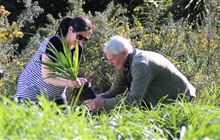Convention on Biological Diversity (CBD)
Introduction
CBD promotes the development of global targets, national strategies and action plans for the conservation and sustainable use of biodiversity.Biodiversity and ecosystem functions and services are deteriorating worldwide.
Adopted at the 1992 Earth Summit in Rio de Janeiro, the United Nations Convention on Biological Diversity (CBD) recognised for the first time in international law that the conservation of biological diversity is “a common concern of humankind”. The agreement covers all ecosystems, species, and genetic resources.
CBD has three main objectives:
- conservation of biological diversity – also known as biodiversity
- sustainable use of its components
- fair and equitable sharing of benefits arising from genetic resources.
With 196 Parties, CBD has near universal participation among countries.
DOC has a significant interest in the ongoing work under CBD, and acts as the primary supporting agency to the Ministry of Foreign Affairs and Trade (MFAT), the lead agency on CBD for New Zealand.
Global biodiversity goals
CBD sets global priorities for biodiversity conservation and sustainable use. It does this through the adoption by its member countries of a global strategy, vision and goals, as well as specific targets setting out where urgent global action is needed to halt the loss of biodiversity.
In 2010, over 190 countries around the world reached global agreement on the Strategic Plan for Biodiversity 2011–2020 and the Aichi Biodiversity Targets. These targets help countries collectively achieve the global goals by providing a framework to establish national plans that consider national circumstances and priorities.
As biodiversity continues to decline globally at an unprecedented rate, and the pressures driving this decline continue to intensify, countries are negotiating a new global biodiversity framework and goals to replace the Aichi Biodiversity targets.
The negotiation of new global biodiversity goals is an opportunity for New Zealand to work with other countries and stakeholders to address the global decline in biodiversity.
- International process to develop the new global framework on CBD website
- CBD Strategic Plan for Biodiversity 2011–2020
New Zealand’s national biodiversity strategy
As a party to CBD, New Zealand is required to have a national biodiversity strategy and action plan. Through the strategy and action plan, New Zealand delivers its obligations under CBD, expressing our commitment to stem the loss of biodiversity worldwide.
DOC is responsible for leading the development of New Zealand’s national biodiversity strategy and action plan, and for reporting regularly on progress towards it.
In August 2020, the New Zealand Government launched Te Mana o te Taiao – Aotearoa New Zealand Biodiversity Strategy 2020. This is New Zealand’s new national biodiversity strategy under CBD.
Te Mana o te Taiao sets out a strategic framework for the protection, restoration and sustainable use of biodiversity, particularly indigenous biodiversity, in New Zealand, from 2020 to 2050.
About the Aotearoa New Zealand Biodiversity Strategy
CBD requires countries to report on progress towards implementing their national strategy and action plan every four years. New Zealand submitted its Sixth National Report to CBD in March 2019.

